Hyperbolic Non-Euclidean World
Ch.34 Figure-8 Knot 
They say that hyperbolic space comes out of what is called figure-8 knot.

The figure-8 knot is a knot of string tied like Fig. (1) and jointed both ends like Fig. (1'). The string is a curved mathematical line, and never touches to itself though it goes over or under itself. That is, the figure-8 knot is a 3-D two-level self-crossing loop. We do not ask the size or shape of it. The diameter of the string is that of a point because a curved line consists of chained points. You may stretch both ends of the string in Fig. (1) up to infinity. It is also called figure-8 knot because the string makes a loop passing through a point of infinity.

The figure-8 knot is often drawn as shown Fig. (2). Fig. (2') is an arranged copy from The KnotPlot Site. The side and back view of the figure-8 knot is the same as you see it now. The vertical view is point symmetry. There is a movable picture in Web, Elementary Topology. Fig. (2'') is a curtained picture of figure-8 knot to see which part is forward or backward. (Other drawings of the figure-8 knot are shown in Fig. (7) and Other pictures of figure-8 knot in [Addenda].)
The complementary space of figure-8 knot is our subject. They say that the figure-8 knot is the simplest to treat its complement. Complement  is a space excluding the figure-8 knot that has lived in the space, namely all of space minus figure-8 knot. You may take it to be a space that has an inviolable discontinuous region. Mathematically, it is expressed that whole set (space) minus subset (figure-8 knot) equals to complementary set (complement
is a space excluding the figure-8 knot that has lived in the space, namely all of space minus figure-8 knot. You may take it to be a space that has an inviolable discontinuous region. Mathematically, it is expressed that whole set (space) minus subset (figure-8 knot) equals to complementary set (complement  ). Fig. (3) shows this situation. And they say, "Complement
). Fig. (3) shows this situation. And they say, "Complement  is a hyperbolic space." Is it true?
is a hyperbolic space." Is it true?
 In 1978 William P. Thurston discovered that majority of knot complements are hyperbolic. (The only knots that are not hyperbolic are so-called torus knots and satellite knots.) And He received the Fields medal (the mathematics version of a Nobel prize) in 1982. In the reason for the prize, it is said that he did revolutionary work! (In 1974 Robert Riley first discovered that the figure-8 is hyperbolic.)
In 1978 William P. Thurston discovered that majority of knot complements are hyperbolic. (The only knots that are not hyperbolic are so-called torus knots and satellite knots.) And He received the Fields medal (the mathematics version of a Nobel prize) in 1982. In the reason for the prize, it is said that he did revolutionary work! (In 1974 Robert Riley first discovered that the figure-8 is hyperbolic.)
What is it? Let us take the figure-8 knot and see Thurston's geometrization. Most of mathematicians I met said, "The figure-8 knot is hard to understand." But I begin to write about it without hesitation. You know, I am Don Quixote. (The world first popular book on the figure-8 knot!)
Thurston says that
the complement of a particular knot can also be expressed
as the union of two tetrahedra in a particular way.
Mathematical expression of what he says is
 - K = T U T' - V ....(1)
- K = T U T' - V ....(1)
where
 = entire space (hypersphere)
= entire space (hypersphere)
K = the figure-8 knot
T, T' = tetrahedra
U = glue (particular union)
V = vertices of T U T'.
* * * * * * *
First let us define our terms and symbols.

Other symbols in our story will be defined when we use.
Topo. complement is a complement prior to the geometrization. It is what we are going to get first.
We often call the complement of the figure-8 knot "Complement" for short.
Also we often write "knot K" instead of writing the figure-8 knot.
One more to be fixed for the beginning.
In topology we say that a coffee cup and a donut are topologically the same (homeomorphic) because they have a hole. You may deform any object as long as it keeps homeomorphism. We regard an object as a set of points. Therefore, to keep homeomorphism you must not disconnect what was connected, nor connect what was not. First of all, one to one mapping must be kept at the beginning and end of deformations.
That is to say,
"adjoining points are adjoining, and separate points are separate"
must be kept.
Let us call it "the rule of homeomorphism".
On the way of our story this rule is to be broken. But it will be homeomorphic again if one re-satisfies the rule of homeomorphism. For example, you cut the string of an entangled knot, and then make it an ordinary loop by rejoining after disentanglement. The loop and knot are homeomorphic. Even if the knot has thickness, it is OK by fitting cutouts as they were.
You might think that we should have a loop instead of figure-8 knot from the beginning so that our story would be much easier. But it is no good because we have to get Topo. complement  of knot K as a knot. We will not worry about knot K itself after we get its information (a shrink-wrapping or like of knot K in our story) for Topo. complement
of knot K as a knot. We will not worry about knot K itself after we get its information (a shrink-wrapping or like of knot K in our story) for Topo. complement  .
.
About dimensions.
In topology a curved line is 1-dimensional, a curved surface is 2-dimensional and a solid body is 3-dimensional. And whatever they are deformed their dimensions do not change. In other words, we pay attention to the object itself rather than a space where it is embedded. If an object has only a length, it is 1-dimensional. If an object has only an area, it is 2-dimensional. And if an object has only a volume (non-empty interior), it is 3-dimensional. Say a balloon in the sky is 2-dimensional because it is only a skin.
* * * * * * *
Now, let us interpret what Thurston says.
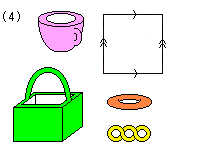 "the union ... in a particular way" means gluing with high technique and full imagination in our story. The gluing will be the key point.
"the union ... in a particular way" means gluing with high technique and full imagination in our story. The gluing will be the key point.
"the complement ... be expressed ..." means that it is possible to change Orig. complement  for Topo. complement
for Topo. complement  that is different from but homeomorphic to Orig. complement
that is different from but homeomorphic to Orig. complement  . What expressed is not Orig. complement
. What expressed is not Orig. complement  but Topo. complement
but Topo. complement  . They sometimes say, "A complement is taken apart in two tetrahedra." It has the same meaning.
. They sometimes say, "A complement is taken apart in two tetrahedra." It has the same meaning.
Topologists often use a common word without distinguishment between homeomorphic and non-homeomorphic. For example, Fig. (4) shows some different objects, coffee cup, a donut, a square with arrow marks and so on. Topologists call all of them in one word, torus (cf. Ch.33).
We are not used to such wording. So we should be careful.
* * * * * * *
Let us see Formula (1).
The equal sign indicates that the left side and the right side are homeomorphic. They should use " " but they often use ordinary "=" instead.
" but they often use ordinary "=" instead.
Formula (1), as well as oral expressions, does not mention what kind of space Topo. complement  is. It is our aim to see that Topo. complement
is. It is our aim to see that Topo. complement  is geometrilized and changed into Geom. complement
is geometrilized and changed into Geom. complement  that is hyperbolic.
that is hyperbolic.
About the left side of formula (1).
The left side is the definition of Orig. complement  . It is not operational. We can not make the subtraction concretely.
. It is not operational. We can not make the subtraction concretely.
The hypersphere  is a whole space in mind at the left side. And in the right side, T U T' is one to one mapping space to
is a whole space in mind at the left side. And in the right side, T U T' is one to one mapping space to  . Do not mistake physical bringing for mapping. (The hypersphere
. Do not mistake physical bringing for mapping. (The hypersphere  is also called 3-sphere.)
is also called 3-sphere.)
Look at Fig. (5). The hypersphere  is a space. It consists of
is a space. It consists of  and a point at infinity
and a point at infinity  .
.
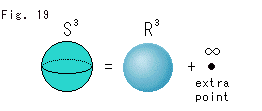
 is 3-dimansional Euclidean space
is 3-dimansional Euclidean space  where we can set a point far from the origin as much as we want except the point of infinity
where we can set a point far from the origin as much as we want except the point of infinity  . We usually regard it as a sphere. But the border of it is not clear. Of course, we can see its inside. But we can not observe
. We usually regard it as a sphere. But the border of it is not clear. Of course, we can see its inside. But we can not observe  itself from the outside.
itself from the outside.
The hypersphere  is 3-dimensional and yet a spherical "surface". However, here we take it as a name for the right side of the formula (2) without question.
is 3-dimensional and yet a spherical "surface". However, here we take it as a name for the right side of the formula (2) without question.
Some people say, "The hypersphere  is also expressed as
is also expressed as  . It shows 3-dimensional." Can you imagine the hypersphere
. It shows 3-dimensional." Can you imagine the hypersphere  through such formula? It is too hard for us. There are other two ways to make the hypersphere
through such formula? It is too hard for us. There are other two ways to make the hypersphere  . Say gluing two solid balls or donut with full interior. Well, these are not our subjects at the present.
. Say gluing two solid balls or donut with full interior. Well, these are not our subjects at the present.
We guess that the hypersphere  are visible if we were in the four dimensional world. In web there are
are visible if we were in the four dimensional world. In web there are
Web1,
Web2,
Web3,
Web4,
Optiverse,
Outside In.
(For Outside In, click "MPEG movie of everting sphere". It is a video.)
About the right side of formula (1).
The right side of the formula (1) can not be gotten by calculating the left side or changing the right side itself. That is to say, the right side is to meet the left side only by telling a story.
How fun it is!
We can not understand what tetrahedra T and T' only by observing the formula (1). We do not care about the size or distortion of tetrahedra. But they have non-empty interior. "non-empty interior" is a region where you can put or set up something. But do not think that some physical matters are packed.
Vertex V is a point that is an incarnation of the figure-8 knot.
* * * * * * *
Now, how do they get complement  out of the entire space
out of the entire space  ? How do they judge it hyperbolic? It is interesting that some mathematicians say one thing and others another for proof. Of course, I often misunderstand what they say. Also I might grovel to authority without knowing. Anyway, let me begin the story.
? How do they judge it hyperbolic? It is interesting that some mathematicians say one thing and others another for proof. Of course, I often misunderstand what they say. Also I might grovel to authority without knowing. Anyway, let me begin the story.
This story takes three steps;
1. Sandwich knot K between two films F and F', and make it in
a shrink-wrapping. (Each of F and F' shoulders Hf. complement 
of Orig. complement  ).
).
Separate film F together with knot K in four parts.
Untwist and join them again then you get tetrahedron T. (Knot K
becomes vertices of T. Faces and the interior of T is not
homeomorphic but correspond to Hf. complement  .)
.)
Follow the same procedure on film F', and get tetrahedron T'.
2. Glue tetrahedra T and T' so that films F and F' meet as they
were, then all vertices become a single point V.
Cut point V off, then you get Topo. complement  entirely as
entirely as
T U T' - V.
3. Replace tetrahedra by regular ideal tetrahedra, then Topo. complement
 becomes Geom. complement
becomes Geom. complement  (
( hyperbolic space
hyperbolic space  )
)
Needless to say, you should think all in topology until geometrization.
Let the figure-8 knot be finite unless specified.
You may cut off vertices of tetrahedra at any stage. But the formula (1) seems to do it after gluing tetrahedra. So we do here.
-*- -*- -*- -*- -*- -*- -*- -*- -*- -*-
[Step 1]
Put the figure-8 knot in  , and get two tetrahedra T and T' with Hf. complement
, and get two tetrahedra T and T' with Hf. complement  each by using films.
each by using films.
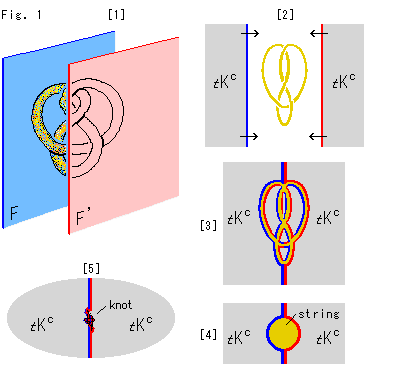
A space called hypersphere  is written in the left side of formula (1). But in the right side, a space to be pasted on films is not specified. If it is not necessary or not able to write such in the formula, they should add a notice. But none. Probably it is an unspoken agreement. Therefore, let us conclude that space for films is Orig. complement
is written in the left side of formula (1). But in the right side, a space to be pasted on films is not specified. If it is not necessary or not able to write such in the formula, they should add a notice. But none. Probably it is an unspoken agreement. Therefore, let us conclude that space for films is Orig. complement  .
.
Look at Fig. (6). We use two films F (sky blue) and F' (pink). They are imaginary and unsubstantial. Sandwich knot K between films F and F', and make it just like a shrink-wrapping. Films F, F' stick to each other except where knot K exists. They together divide Orig. complement  in two and carry Hf. complement
in two and carry Hf. complement  (gray) each. You may imagine that F and F' are adhesive tapes, and Hf. complement
(gray) each. You may imagine that F and F' are adhesive tapes, and Hf. complement  is pasted on them. The picture at right bottom in Fig. (6) shows a cross section of the string of knot K with films F and F'. The left bottom in Fig. (6) is an image picture that Orig. complement
is pasted on them. The picture at right bottom in Fig. (6) shows a cross section of the string of knot K with films F and F'. The left bottom in Fig. (6) is an image picture that Orig. complement  is divided in two. Knot K is sandwiched by two Hf. complement
is divided in two. Knot K is sandwiched by two Hf. complement  .
.
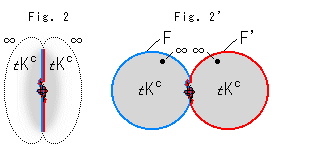
We consider films F and F' as spheres because they expand to infinity  and get back to finite as shown in Fig. (6'). Fig. (6'') is an imaginary picture of their cross sections. But remember films F and F' are fully stuck (not at a point but covered the whole) each other though they are drawn separately in right and left. It shows that films F and F' are holding their Hf. complement
and get back to finite as shown in Fig. (6'). Fig. (6'') is an imaginary picture of their cross sections. But remember films F and F' are fully stuck (not at a point but covered the whole) each other though they are drawn separately in right and left. It shows that films F and F' are holding their Hf. complement  . We can not say which side has a point of infinity but they actually have it commonly.
. We can not say which side has a point of infinity but they actually have it commonly.
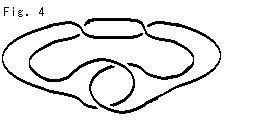
A film crosses itself and twists, but it has the front and back. It is not like Moebius strip that has only one surface. So it is possible to divide Orig. complement  in two Hf. complements
in two Hf. complements  . You might clarify it if you draw knot K like Fig. (7). But it is not easy to understand. You will see it with Fig. (9) to (11) below.
. You might clarify it if you draw knot K like Fig. (7). But it is not easy to understand. You will see it with Fig. (9) to (11) below.
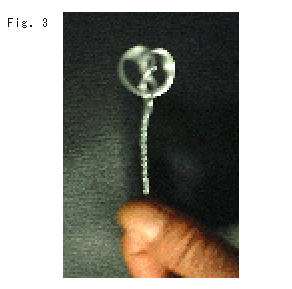 Fig. (8) is a photo of a metal wire Knot K dipped in shampoo. But it is hard to see, isn't it? We are able to see a certain part of the film but not the whole. It is such that the wire with the film goes through another part of the film (the wire crosses in two-level and the film intersects itself). The film is transparent but it is not easy to see beyond the film surface. There is no way to see the whole shape of the film on knot K unless you draw it apart. All you have to do is to cut the film in some pieces along a line of film intersection. But, seeing Fig. (3''), there are so many color change points where the film intersects itself. I can not find proper cut-line. I had no choice but I could refer to A Topological Picturebook by George K. Francis. You will see the whole shape with Fig. (9) to (11) below.
Fig. (8) is a photo of a metal wire Knot K dipped in shampoo. But it is hard to see, isn't it? We are able to see a certain part of the film but not the whole. It is such that the wire with the film goes through another part of the film (the wire crosses in two-level and the film intersects itself). The film is transparent but it is not easy to see beyond the film surface. There is no way to see the whole shape of the film on knot K unless you draw it apart. All you have to do is to cut the film in some pieces along a line of film intersection. But, seeing Fig. (3''), there are so many color change points where the film intersects itself. I can not find proper cut-line. I had no choice but I could refer to A Topological Picturebook by George K. Francis. You will see the whole shape with Fig. (9) to (11) below.
See Shape of Film. Also you may visit Knot Spanning Surfaces in Web.
* * * * * * *
Let film F make tetrahedron T.
Fig. (9) shows its process. One side of knot K is colored dark brown for easy to see. Gray area is the backside. Knot K is on film F (sky blue) with Hf. complement  . Figure (*) right up in Fig. (9) shows red and green partitions to divide film F together with knot K in four. Small white delta on each partition shows its direction.
. Figure (*) right up in Fig. (9) shows red and green partitions to divide film F together with knot K in four. Small white delta on each partition shows its direction.
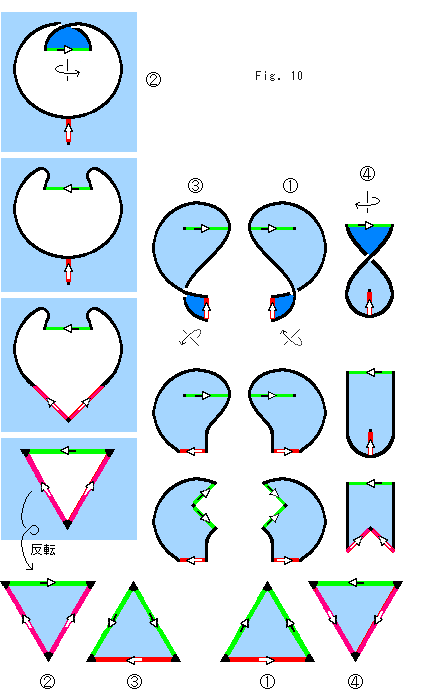
We proceed as shown in Fig. (9),
1. Locate two partitions.
2. Divide film F in four.
3. Untwist film F.
4. Cut partitions in V-shape.
5. Make triangles by shortening strings to a point.
To untwist film F red partitions are turned with green ones fixed.
What we say, "shortening strings to a point" is mathematically a mapping of many to one.
We inverted the outside of part of film F to the inside of triangle A in order to get Hf. complement  into tetrahedron T (cf. Ch.23).
into tetrahedron T (cf. Ch.23).
Since knot K is placed in  , the view of it is just as shown in figures. But, when you observe it together with film F, do not forget that film F is on the hyperspher
, the view of it is just as shown in figures. But, when you observe it together with film F, do not forget that film F is on the hyperspher  . (Triangles at the bottom of Fig. (9) are rearranged in order.
. (Triangles at the bottom of Fig. (9) are rearranged in order.
(To tell the truth, it is because I drew Fig. (13) first. But luckily, by this mistake, we will not need to rearrange triangles for tetrahedron T'.)
 In Fig. (9) it looks that parts of film F around partitions are triply taken. But it is not true.
In Fig. (9) it looks that parts of film F around partitions are triply taken. But it is not true.
Fig. (10) shows the view around the left end of the green partition observed from the left side.
Fig. (11) shows the view around the bottom end of the red partition observed from the bottom.

We untwisted and inverted parts of film F. However, a part of Hf. complement  (1/4 of complement
(1/4 of complement  ) on each triangle keeps the rule of homeomorphism except edges as shown in Fig. (12). Edges are not one to one mapping to Hf. complement
) on each triangle keeps the rule of homeomorphism except edges as shown in Fig. (12). Edges are not one to one mapping to Hf. complement  because triangles have common points on edges. It will be repaired when we glue tetrahedra T and T' in [Step 2]. Here we do not pay attention to topology of knot K because we do not care about it.
because triangles have common points on edges. It will be repaired when we glue tetrahedra T and T' in [Step 2]. Here we do not pay attention to topology of knot K because we do not care about it.
We now got four triangles A, B, C and D in  (finite). They have a quarter of Hf. complement
(finite). They have a quarter of Hf. complement  each.
each.
* * * * * * *
Now we make tetrahedron T with triangles A, B, C and D as shown in Fig. (13).
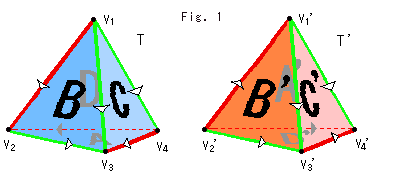 Color and direction of edges must meet each other for joining four triangles. Only triangle D in Fig. (9) has to be turned over. This construction is to get a single sheet of film F again without twisting. Black spots on vertices are points shortened strings. Separated pieces of knot K get pushed to vertices.
Color and direction of edges must meet each other for joining four triangles. Only triangle D in Fig. (9) has to be turned over. This construction is to get a single sheet of film F again without twisting. Black spots on vertices are points shortened strings. Separated pieces of knot K get pushed to vertices.
Four parts of Hf. complement  are gathered in one again and packed in triangle T (excluding vertices but faces). But this Hf. complement
are gathered in one again and packed in triangle T (excluding vertices but faces). But this Hf. complement  is not homeomorphic to that of original.
is not homeomorphic to that of original.
Seeing Fig. (13), the rule of homeomorphism is not kept. Number of edges (former partitions) is six. It is OK to push Hf. complement  into triangle T, but "adjoining points are adjoining, and separate points are separate" is not kept.
into triangle T, but "adjoining points are adjoining, and separate points are separate" is not kept.
However, it will be repaired when tetrahedron T is glued to tetrahedron T' that will be made next.
It is not necessary to locate partitions as shown in (*) of Fig. (9) as long as we can get appropriate triangles.
If we could make a cube with some partitions, our story might be different. But it is impossible. Therefore, it is inevitable to get a tetrahedron from knot K.
* * * * * * *
Now we make another tetrahedron T'.
It is Fig. (14). This time, we use film F'. Make tetrahedron T' as shown in Fig. (14') using the same procedure as that of film F. And label A', B', C', D' on faces of tetrahedron T' correspondingly to faces A, B, C, D on tetrahedron T. (It is not simply turning over triangles A, B, C, D.) Then tetrahedron T' (excluding vertices but faces) contains another Hf. complement  .
.
Tetrahedra T and T' are not defined in size. Tetrahedron T has knot K and Hf. complement  in its inside with faces and vertices. So does tetrahedron T'. In another words, tetrahedra T and T' together contain knot K and the whole Orig. complement
in its inside with faces and vertices. So does tetrahedron T'. In another words, tetrahedra T and T' together contain knot K and the whole Orig. complement  . Naturally the content is not the vast and boundless complement
. Naturally the content is not the vast and boundless complement  as it was unless we swell infinitely tetrahedra T and T'.
as it was unless we swell infinitely tetrahedra T and T'.
Then what on earth is the outside of those tetrahedra? Well, do not guess that it is the outside of universe where there is nothing, no space, no matter, not even existence nor non-existence. Because tetrahedra T and T' are images as mapping. The outside is nonsense. We will discuss this point at [Another point of infinity] in the end of [Step 2].
-*- -*- -*- -*- -*- -*- -*- -*- -*- -*-
[Step 2]
We glue tetrahedra T and T'.
We have pushed knot K to vertices of tetrahedra T and T'. We now stick films F and F' each other again without inserting knot K. You may imagine that a shrink-wrapping is squeezed and flat excluding contents. Of course, faces must meet as they were at the beginning.
Glue faces A to A', B to B', C to C' and D to D'. Colors and directions of edges must meet each other. No need to say, glue tetrahedra T and T' by outside to outside. Directions of labels (not faces) are free from identification.
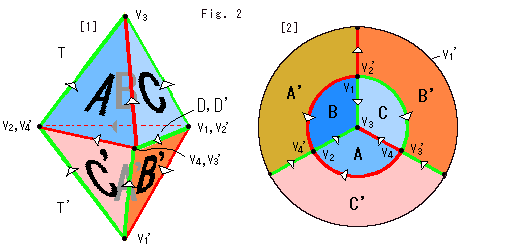
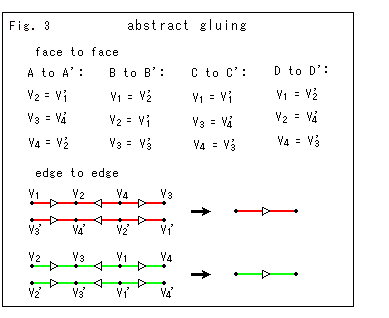 Fig. (15) above shows a hexahedron with faces D and D' glued. Cut it open at vertex
Fig. (15) above shows a hexahedron with faces D and D' glued. Cut it open at vertex  ' and unfold it as shown in Fig. (15'). Glued faces D and D' are under the inner disk A-B-C. You can glue no more by ordinary way, but we can abstractly do.
' and unfold it as shown in Fig. (15'). Glued faces D and D' are under the inner disk A-B-C. You can glue no more by ordinary way, but we can abstractly do.
Since this gluing is abstract, we do not think about space where we do. (Do not imagine gluing in the four-dimensional world like SF novels. First of all, any knot gets untied in the four-dimensional world, and we can not make any story.)
We will inquire into the abstract gluing more and more.
Fig. (16) shows the gluing rule. It says to make edges the same direction by color and to identify vertices by face. But the latter will do. It joins two Hf. complements  together and forms a single Topo. complement
together and forms a single Topo. complement  . Because the gluing repairs two Hf. complements
. Because the gluing repairs two Hf. complements  , face to face as they were (cf. Fig. (23), (24)). Both faces A and A' are inverted but what they are glued does not break the rule of homeomorphism.
, face to face as they were (cf. Fig. (23), (24)). Both faces A and A' are inverted but what they are glued does not break the rule of homeomorphism.
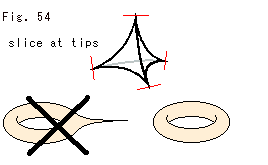 We glue tetrahedra T and T' by outside to outside. Do not glue only faces like [a] in Fig. (16') because every face has a part of Hf. complement
We glue tetrahedra T and T' by outside to outside. Do not glue only faces like [a] in Fig. (16') because every face has a part of Hf. complement  (1/4 of
(1/4 of  ). But contents (complement
). But contents (complement  ) of tetrahedra T and T' do not expand like triangular prisms all the way as shown in [b]. Nor, one is surrounded by the other like [c]. They of course not fuse in each other. Our gluing is completely abstract.
) of tetrahedra T and T' do not expand like triangular prisms all the way as shown in [b]. Nor, one is surrounded by the other like [c]. They of course not fuse in each other. Our gluing is completely abstract.
* * * * * * *
When we carry out this abstract gluing,
all vertices of tetrahedra T and T' gather and become a single point V. 6 red edges are identified and become a single red edge. Similarly 6 green edges become a single green edge. Each pair of faces is identified and the number of them is totally four. Hence the glued tetrahedra T and T' is now a three-dimensional strange solid with 1 vertex, 2 edges and 4 faces.
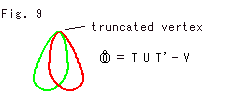 Fig. (17) is what we are forced to draw a picture of this strange solid.
Fig. (17) is what we are forced to draw a picture of this strange solid.
This picture is something like a magic bag. It is transparent but hides the contents except its frame (edges). If you tear this bag, two visible tetrahedra T and T' come out.
We can catch a glimpse of the strange solid but never full picture. But people in the four-dimensional world can see the entire shape of the strange solid. However, the strange solid itself is absolutely three-dimensional. The reason why it is invisible is because we are unable to draw it.
Let us imitate the famous book "Flatland" to explain what exists and yet invisible.
~~~~~~~~~~~~~~~~~~~~~~~~
Mr. E lives in the three dimensional world. Flatland is the two dimensional world where everything is flat. The sky, too. Mr. S is a Flatlander.
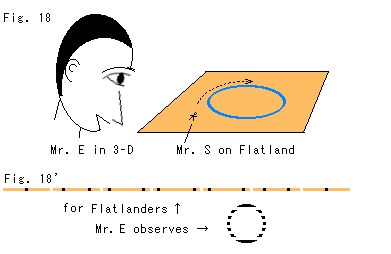 Look at Fig. (18). Mr. E is observing Flatland. There is a something blue in Flatland. He can see the blue one entirely and recognize it as a circle immediately. In Flatland the blue one looks like a segment for Mr. S.
Look at Fig. (18). Mr. E is observing Flatland. There is a something blue in Flatland. He can see the blue one entirely and recognize it as a circle immediately. In Flatland the blue one looks like a segment for Mr. S.
Mr. S wondered what beyond the segment is. So he went along the blue one. He went on and on. Then he came back where he started. He thought it must be what is called a circle. But he has never seen its entire figure. He had learned its mathematical formula at school, and he imagined this way and that. It is impossible for him to imagine as Mr. E does. He can not have any 3-D image. To draw a circle he has to walk along a certain curve with a pen on his side. Remember both Mr. S and his desk are leveled. And his drawing likewise looks a segment for Flatlanders. It is the same to Mr. S himself.
Consequently he perceived that the story how he abstractly grasped a circle is a circle. Then he published his idea in a magazine.
But, oh! He was brought into court and blamed for that he cheated the people by telling all the details of what invisible even though existence. Mr. S explained with the picture of that line as hard as he could. However, no juror accepted him. And he was jailed.
In the jail he found that if the circle in his mind is sliced like Fig. (18'), he could show the entire image though chopped. But he did not apply for a new trial because he was very much afraid of jurors who are men of limited imagination.
It was 120 years ago. There is a rumor that he is still alive. And he is staying in a comfortable room for a mathematical clever criminal.
~~~~~~~~~~~~~~~~~~~~~~~~
Raise up dimension of this story by one, and then it will be true in our three-dimensional world for the strange solid. The line that Mr. S drew corresponds to our strange solid. That is the truth that one can not see a full picture even if it takes place right before our eyes. Slicing is a good idea but we do not know what to do. First of all, we do not yet decide the shape of tetrahedra T and T'. (We will often take this subject, visible or invisible.)
 Now, cut off vertex V of the strange solid as shown in Fig. (19). The remainder including faces is Topo. complement
Now, cut off vertex V of the strange solid as shown in Fig. (19). The remainder including faces is Topo. complement  that we have wanted, that is T U T' - V. It has no vertex, 2 edges and 4 faces.
that we have wanted, that is T U T' - V. It has no vertex, 2 edges and 4 faces.
The cut end of Topo. complement  has no end point for outward. Because we can not find a point next to a point. It is so-called an open interval.
has no end point for outward. Because we can not find a point next to a point. It is so-called an open interval.
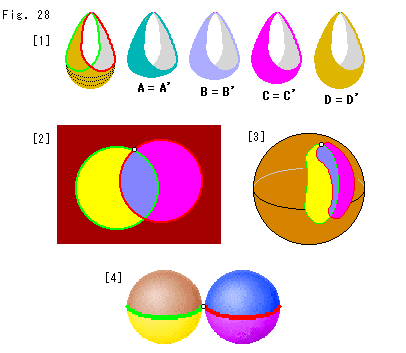 Fig. (20) shows some trial imaginary pictures of Topo. complement
Fig. (20) shows some trial imaginary pictures of Topo. complement  . Four faces are classified by color. A small white spot on [2] to [4] is the vestige of deleted vertex V.
. Four faces are classified by color. A small white spot on [2] to [4] is the vestige of deleted vertex V.
[1]: The left picture is a finished goods with four layer bags. The three pictures right are bags of glued faces, A to A', B to B', C to C' and D to D'. Each bag has a face with its contents.
[2]: There is an idea that glued two solid balls become a hypersphere. Then, abstractly glued tetrahedra T and T' without vertex V should be something like it. The picture is drawn as a plane based on this idea.
[3]: A picture drawn as a sphere instead of the plane of [2].
[4]: Two balls are chained at lacked point of V. They clearly show 2 edges and 4 faces.
Well, none of these shows how four faces surround Topo. complement  . (Later we will try more pictures.)
. (Later we will try more pictures.)
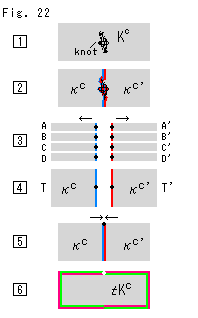
It is impossible for us with Fig. (19) or (20) to judge if Topo. complement  is homeomorphic to Orig. complement
is homeomorphic to Orig. complement  . We wish to have a model that we could draw in, but none.
. We wish to have a model that we could draw in, but none.
However, though we can not see Topo. complement  by our eyes, we are able to say that it is homeomorphic to Orig. complement
by our eyes, we are able to say that it is homeomorphic to Orig. complement  because the gluing rule assures to maintain homeomorphism.
because the gluing rule assures to maintain homeomorphism.
Fig. (21) shows how films F and F' have met and parted.
 is the first stage (
is the first stage ( - K) that has knot K and Orig. complement
- K) that has knot K and Orig. complement  .
.
 shows that films F, F' sandwich knot K and divide Orig. complement
shows that films F, F' sandwich knot K and divide Orig. complement  in two.
in two.
 shows that films F and F' are separated in four triangles respectively. Every triangle has corresponding part of Hf. complement
shows that films F and F' are separated in four triangles respectively. Every triangle has corresponding part of Hf. complement  .
.
 shows that triangles are joined, and tetrahedra T and T' are formed.
shows that triangles are joined, and tetrahedra T and T' are formed.
 shows that tetrahedra T, T' are glued, and films F, F' are stuck again to each other exactly as
shows that tetrahedra T, T' are glued, and films F, F' are stuck again to each other exactly as  . Vertex V is drawn at a corner of films F, F'. The strange solid (T U T') is made.
. Vertex V is drawn at a corner of films F, F'. The strange solid (T U T') is made.
 shows Topo. complement
shows Topo. complement  (T U T' - V). It is surrounded with two edges. A lacked point on the edges is the trace of deleted vertex V. Films F, F' are now useless and erased. Topo. complement
(T U T' - V). It is surrounded with two edges. A lacked point on the edges is the trace of deleted vertex V. Films F, F' are now useless and erased. Topo. complement  is an open set.
is an open set.
=======================
Thus as Thurston says,
The complement of figure-8 knot is obtained from (abstractly)
glued two tetrahedra which vertices are eliminated.
And formula (1) is proved (explained), too.
Some mathematicians say that it is the demonstration if one convinces oneself. How about you?
=======================
It is possible to get Topo. complement  without making tetrahedra T, T'. All we have to do is that we directly glue triangles of Fig. (9) and (14') following the gluing rule in Fig. (16) and cut vertex V off. However, if we do so, we will miss relations between Topo. complement
without making tetrahedra T, T'. All we have to do is that we directly glue triangles of Fig. (9) and (14') following the gluing rule in Fig. (16) and cut vertex V off. However, if we do so, we will miss relations between Topo. complement  and tetrahedra T, T'. You know,
and tetrahedra T, T'. You know,  is invisible at any rate.
is invisible at any rate.
The left side of formula (1)  - K is vast and boundless complement. But the right side T U T' - V is Topo. complement
- K is vast and boundless complement. But the right side T U T' - V is Topo. complement  (strange solid without vertex V) that is packed in T U T'. You may feel some difference in size between these complements. But remember, in topology we do not care about size and shape as long as homeomorphism is kept.
(strange solid without vertex V) that is packed in T U T'. You may feel some difference in size between these complements. But remember, in topology we do not care about size and shape as long as homeomorphism is kept.
There is the whole universe in your coffee cup now! You drink the universe every morning, don't you? We guess that points in coffee and points in the universe correspond to each other by one to one mapping. Because both coffee and the universe have infinite number of points even if they are not homeomorphic nor countable.
* * * * * * *
Fig. (22) and Fig. (23) below are pictures of our story so far.
(a) in Fig. (22) is continued from the picture bottom left in Fig. (6). (a) and (d) are in Euclidean space. (a) is in condition  , and (d) is in condition
, and (d) is in condition  . Symbol "
. Symbol " " is a stressed mark for homeomorphism.
" is a stressed mark for homeomorphism.

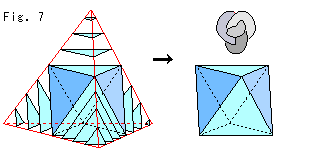
Fig. (23) above is mappings from the beginning. Square pictures underneath are copies of Fig. (21) for reference. The actual number of members in each set is infinity except vertex V in <5>.
Brown arrow lines and dots are from Orig. complement  to Topo. complement
to Topo. complement  . White dots indicate homeomorphism to Orig. complement
. White dots indicate homeomorphism to Orig. complement  . Arrow lines cross over other lines between <3> and <4>, and represent non-homeomorphic to Orig. complement
. Arrow lines cross over other lines between <3> and <4>, and represent non-homeomorphic to Orig. complement  though one to one mapping is kept. They cross over other lines again between <4> and <5>, and repair themselves to be homeomorphic.
though one to one mapping is kept. They cross over other lines again between <4> and <5>, and repair themselves to be homeomorphic.
Black arrow lines and dots are from the original knot K to vertex V. One to one mapping is broken where arrow lines get entangled. ("cross over" and "entangle" are not general drawing way in mapping.)
To tell the truth, brown arrow lines and dots in <2> to <5> are not accurate. Surfaces of films F and F' are common parts. The common surfaces meet and apart in <2> to <4>. Edges are included in surfaces. And in <5> all of them will perfectly be repaired as one to one mapping to Orig. complement  in <1>. (These are omitted in Fig. (23) for simple.)
in <1>. (These are omitted in Fig. (23) for simple.)
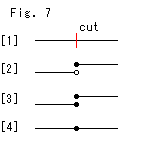 We have used different colors for surfaces even where they were stuck each other. But it is not right.
We have used different colors for surfaces even where they were stuck each other. But it is not right.
Look at Fig. (24). Suppose a number line is cut. If one end has an end point (black dot), the other end has no end point (white dot) as shown in [a]. It is usual, isn't it? In topology, however, they often say that each end has an end point as shown in [c]. And identify both ends for rejoining as shown not in [b] but in [d].
* * * * * * *
Another point of infinity  k.
If we fix one of vertices of tetrahedra when we glue them, the fixed point will be vertex V. We may choose any point for the fixed point if it was on original knot K. But, if it was not, we must find an extra point that does not cause anti-mapping between Orig. complement
k.
If we fix one of vertices of tetrahedra when we glue them, the fixed point will be vertex V. We may choose any point for the fixed point if it was on original knot K. But, if it was not, we must find an extra point that does not cause anti-mapping between Orig. complement  and Topo. complement
and Topo. complement  . Then the point must be outside of the hypersphere
. Then the point must be outside of the hypersphere  . Does such a point exist?
. Does such a point exist?
 contains all the points within finite distance from the origin. The hypersphere
contains all the points within finite distance from the origin. The hypersphere  is considered the whole universe because it consists of
is considered the whole universe because it consists of  and a point of infinity
and a point of infinity  . Then, there is not any point besides those in the hypersphere
. Then, there is not any point besides those in the hypersphere  .
.
Yes, there exist extra points. Orig. complement  is a complement of knot K when the hypersphere
is a complement of knot K when the hypersphere  is the whole set. That is, a complement depends on what the whole set is. There is no reason for that the hypersphere
is the whole set. That is, a complement depends on what the whole set is. There is no reason for that the hypersphere  is the universe.
is the universe.
What is the point that is not in the hypersphere  ?
?
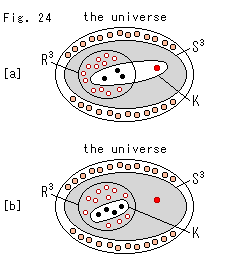
It is an extra point at infinity. The number of points of infinity is numberless. You know a line at infinity (cf. Ch.27). Also we said, "We should define infinity rather than making a question" at the end of Ch.18.
Fig. (25) shows two cases of the first stage. The largest enclosure is the universe. Gray area is Orig. complement  . The inner white area is knot K. Small white and black dots are points in
. The inner white area is knot K. Small white and black dots are points in  . Pink and red dots are points at infinity. The red dot is only one point at infinity to form the hypersphere
. Pink and red dots are points at infinity. The red dot is only one point at infinity to form the hypersphere  . To distinguish from other points at infinity that are outside of the hypersphere
. To distinguish from other points at infinity that are outside of the hypersphere  it is colored in red. The number of all dots, except the red one, is actually countless.
it is colored in red. The number of all dots, except the red one, is actually countless.
[a]: Case that a point on knot K is at infinity.
[b]: All points on knot K are in  and they are within finite distance.
and they are within finite distance.
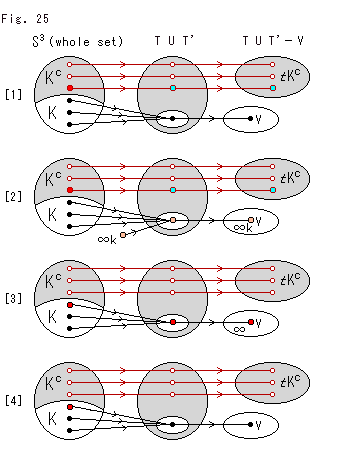 Look at Fig. (25'). The hypersphere
Look at Fig. (25'). The hypersphere  is the whole set. Black and white dots are always within finite distance. The red dot is the point at infinity
is the whole set. Black and white dots are always within finite distance. The red dot is the point at infinity  , and sky blue dot is a map of the red one. The pink dot is also the point at infinity but different from the red one, and denoted by
, and sky blue dot is a map of the red one. The pink dot is also the point at infinity but different from the red one, and denoted by  k. Brown arrows connect those homeomorphic. The dot in white area of the center row (T U T') is a fixed point for gluing.
k. Brown arrows connect those homeomorphic. The dot in white area of the center row (T U T') is a fixed point for gluing.
[1]: All points on the original knot K are within finite distance. One of them is chosen for the gluing.
[2]: All points on the original knot K are within finite distance. But the point at infinity  k that the hypersphere
k that the hypersphere  does not have is chosen for the gluing.
does not have is chosen for the gluing.
[3]: A point on the original knot K is the point at infinity  . And it is chosen for the gluing.
. And it is chosen for the gluing.
[4]: A point on the original knot K is the point at infinity  . But another point on the original knot K that is within finite distance is chosen for the gluing.
. But another point on the original knot K that is within finite distance is chosen for the gluing.
In any case Topo. complement  is homeomorphic to Orig. complement
is homeomorphic to Orig. complement  .
.
When the last dwelling place of knot K is at a point of infinity  or
or  k (case [2] or [3]), some says that tetrahedra T and T' under gluing get smaller and smaller, and finally disappear. How do you think?
k (case [2] or [3]), some says that tetrahedra T and T' under gluing get smaller and smaller, and finally disappear. How do you think?
See also True Character of Vertices. It is about vertex V that was deleted.
-*- -*- -*- -*- -*- -*- -*- -*- -*- -*-
[Step 3]
Geometrization.
To geometrilize is to let a space have a concrete geometry. They often say, "give a geometric structure" for the geometrization. Geometry is what distances are kept. "kept" means that an object is constant in size and shape, and space has a certain invariable metric.
What we are going to geometrilize is not Topo. complement  . However, as a result, it will be a fact that Topo. complement
. However, as a result, it will be a fact that Topo. complement  is geometrilized. We can not directly geometrilize Topo. complement
is geometrilized. We can not directly geometrilize Topo. complement  . Because Topo. complement
. Because Topo. complement  is abstract, and mathematical expression we have is only
is abstract, and mathematical expression we have is only  = T U T' - V . Therefore we go back to the stage before the gluing. Namely, we decide the shape of tetrahedra T and T'. In other words, we produce what geometrilized rather than changing an object from non-geometrilized to geometrilized.
= T U T' - V . Therefore we go back to the stage before the gluing. Namely, we decide the shape of tetrahedra T and T'. In other words, we produce what geometrilized rather than changing an object from non-geometrilized to geometrilized.
They say that all we have to do is to use regular ideal tetrahedra (cf. Ch.32) as tetrahedra T and T' for the geometrization.
* * * * * * *
Space
* * * * * * *
It is a lie that space we will get by the geometrization is hyperbolic space. Such space is not being found. (I myself had thought that hyperbolic geometry would be found by another approach that is different from Lobachevsky's idea.)
Hyperbolic space is ready prior to the gluing. And the geometrization is to get what has concrete shape that fits in hyperbolic space.
It is correct. However, topologists say, "What glued is a manifold, and it is space. In short, what glued is space." It seems that they create space. We do not know whether it is whole or a part.
Let us make it clear as follows.
Hyperbolic space is the whole hyperbolic space that we grasp as a model.
(The model is Poincare ball for example.)
* * * * * * *
Procedure of geometrization
* * * * * * *
To see what geometrization procedure is we compare regular ideal tetrahedra with what we learned in previous Ch.33. The table below contains the figure-8 knot of which column is filled by imitating others. (We are not yet sure if the regular ideal tetrahedra are suitable.)
 Glued product in the above table is a representation of what glued abstractly and placed in Euclidean space. As to 3-torus and figure-8 knot, we can not draw any glued product. In general their glued product has no name.
Glued product in the above table is a representation of what glued abstractly and placed in Euclidean space. As to 3-torus and figure-8 knot, we can not draw any glued product. In general their glued product has no name.
The two-holed torus in the above table, the procedure for the geometrization is;
To let 2-D space be hyperbolic plane surface, and
a regular octagon be a hyperbolic regular octagon with 45 inner angles.
inner angles.
They say that it results "Two-holed torus is geometrilized." If you regard the two-holed torus as space, then it results that the space is geometrilized.
After this geometrization,
We can tile the hyperbolic plane surface with this hyperbolic regular
regular octagon.
We can abstractly tile the hyperbolic plane surface with abstractly
glued one though invisible.
We can represent a double-float (surface) in Euclidean space as glued one.
They also say, "a double-float has hyperbolic geometry" though it does not have surface like Beltrami's Pseudo-sphere. Their wording actually indicates the two-holed torus or the hyperbolic regular octagon with 45 inner angles. To be homeomorphic is different from to have the same geometry. Nevertheless, topologists use such a wording.
inner angles. To be homeomorphic is different from to have the same geometry. Nevertheless, topologists use such a wording.
Now, our geometrization of figure-8 knot will be as follows if we imitate the two-holed torus;
To let 3-D space be hyperbolic, and
tetrahedra T, T' without vertices be regular ideal tetrahedra.
It will result "The complement of figure-8 knot is geometrilized", won't it?
Regarding those after this geometrization, we will see later.
* * * * * * *
Vertices of ideal tetrahedra
* * * * * * *
We are going to use ideal tetrahedra. First let us think over again about vertices of ideal tetrahedra.
It is known that an ideal tetrahedron has no vertex in Poincare's ball (radius r < 1). But are you sure that it has vertices at infinity  (r = 1)? To tell the truth, such is a fiction. Edges of the ideal tetrahedron (ideal edges) are hyperbolic parallel lines. Everything has been OK'd on the assumption that hyperbolic parallel lines meet each other at a point of infinity. However, it is because of that we have actually not used such a point though we discussed lots about the infinite.
(r = 1)? To tell the truth, such is a fiction. Edges of the ideal tetrahedron (ideal edges) are hyperbolic parallel lines. Everything has been OK'd on the assumption that hyperbolic parallel lines meet each other at a point of infinity. However, it is because of that we have actually not used such a point though we discussed lots about the infinite.
Now let us make a new definition.
Hyperbolic parallel lines get unlimitedly closed to
but never meet each other whatever they extend.
And we say, "There is no vertex of an ideal tetrahedron at all." Be an opportunist even if you have some objections. We do not intend to deny Lobachevsky's postulate (cf. Ch.5, Ch.6) All in all, we agree
 > 0 .
> 0 .
One of worries about using regular ideal tetrahedra cleared up now.
Hereafter we denote regular ideal tetrahedra by t and t'. Regular ideal tetrahedron t corresponds to tetrahedron T, and so does t' to T'.
Regular ideal tetrahedra t and t' do not depend on vertices of tetrahedra T and T' because vertices were deleted before.
* * * * * * *
Dihedral angle
* * * * * * *
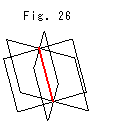 Tetrahedra T and T' together have 6 red edges and 6 green edges to be glued in one red edge and one green edge respectively. That is to say, 6 dihedral angles gather at a place. (A dihedral angle is the angle formed by two intersecting faces.) Therefore, it is quite convenient for us to use regular ideal tetrahedra t and t' because their dihedral angles are exactly 60
Tetrahedra T and T' together have 6 red edges and 6 green edges to be glued in one red edge and one green edge respectively. That is to say, 6 dihedral angles gather at a place. (A dihedral angle is the angle formed by two intersecting faces.) Therefore, it is quite convenient for us to use regular ideal tetrahedra t and t' because their dihedral angles are exactly 60 . That is, 60
. That is, 60 x 6 = 360
x 6 = 360 . (On regular octagons eight of them gather at every vertex because their inner angle is 45
. (On regular octagons eight of them gather at every vertex because their inner angle is 45 .)
.)
Fig. (26) is what we imagine. The same thing happens with green edges at a time. Do not forget that they are abstractly done.
Reason why we choose regular ideal tetrahedra is now cleared with this abstraction.
* * * * * * *
Manifold
* * * * * * *
Using regular ideal tetrahedra t and t', can we really give geometrical structure to Topo. complement?
It is necessary for the geomerization that Topo. complement  is what is called a manifold. A manifold is a space in which certain geometry stands up equally in neighborhood of every point. That is, a small sphere having a common geometry around any point is available. Let us simply imagine it as something smooth without edges.
is what is called a manifold. A manifold is a space in which certain geometry stands up equally in neighborhood of every point. That is, a small sphere having a common geometry around any point is available. Let us simply imagine it as something smooth without edges.
They say
a) What an open sub set in a manifold is manifold,
and
b) What homeomorphic to a manifold is manifold.
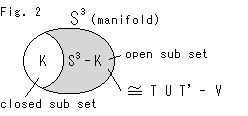
Look at Fig. (27). Hypersphere  is manifold. Orig. complement
is manifold. Orig. complement  is an open sub set in the hypersphere
is an open sub set in the hypersphere  . That is, following a) above, Orig. complement
. That is, following a) above, Orig. complement  is manifold.
is manifold.
And Topo. complement  is homeomorphic to Orig. complement
is homeomorphic to Orig. complement  . Therefore, following b) above, we can say that Topo. complement
. Therefore, following b) above, we can say that Topo. complement  is manifold.
is manifold.
(Knot K is a closed set because it is a loop. It includes what passes a point at infinity. However, the above result is not influenced by knot K.)
We now understand that Topo. complement  is what we can geometrize. (cf. Euler number on 3-D in [Addenda].)
is what we can geometrize. (cf. Euler number on 3-D in [Addenda].)
* * * * * * *
Physical gluing
* * * * * * *
Let us try to illustrate a gluing with regular ideal tetrahedra. We know it is impossible, but see what it will look like.
We remember that we could get a double-float by physical gluing the hyperbolic regular octagon though we can not see what glued abstractly. It is because that the hyperbolic regular octagon is two-dimensional and the double-float is three-dimensional. We want to imitate it. But regular ideal tetrahedra are three-dimensional. So it is too much to ask unless we live in the four dimensional world. Nevertheless, we are going to try.
If we see Fig. (13) and Fig. (14) carefully, we find that three incoming arrows on regular ideal tetrahedron t gather at vertex  and that incoming arrows on regular ideal tetrahedron t' gather at vertex
and that incoming arrows on regular ideal tetrahedron t' gather at vertex  . So we take vertices
. So we take vertices  and
and  as a point of infinity
as a point of infinity  , and put regular ideal tetrahedra in the upper half space H3+. (You may take
, and put regular ideal tetrahedra in the upper half space H3+. (You may take  and
and  instead.) Here we denote only the upper infinity in the upper half space H3+ by
instead.) Here we denote only the upper infinity in the upper half space H3+ by  without worry about the difference between
without worry about the difference between  and
and  k.
k.
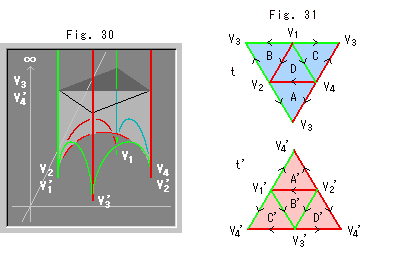
Fig. (28) shows the inside of regular ideal tetrahedra t and t' that are cut and opened at those vertices  and
and  . As you see, we can glue face A to face A' or C to C' right away. In [Step 2] we glued outside to outside. It was just for easy to think. Gluing inside to inside will also do because the result is the same.
. As you see, we can glue face A to face A' or C to C' right away. In [Step 2] we glued outside to outside. It was just for easy to think. Gluing inside to inside will also do because the result is the same.
Glue faces A and A' and get a regular ideal hexahedron and placed it in the upper half space H3+.
Fig. (29) shows it. The glued face is colored in gray on the way down. Face D and B' are bases (spherical). (It does not go well if you glue base to base.)
Fig. (30) below is what we are going to glue face C and C' of this hexahedron. A chained line separates pictures. The left side of the chained line is operable in the upper half space. The right side is not operable in the upper half space but in abstract. Circled numbers  to
to  are labels on edges that do not go up to a point of infinity. Joint number
are labels on edges that do not go up to a point of infinity. Joint number 
 means an identified edge of
means an identified edge of  and
and  .
.
[a]: The hexahedron is deformed to a rectangular parallelepiped for easy to see. Faces C' and D' are transparent. Brown surface of glued face A = A' that we are looking is the outside of face A. Striped faces are C and face C'. They are facing inside to inside each other as surfaces of the rectangular parallelepiped.
[b]: The bird's-eye view of [a].
[c]: Faces C and C' are glued by force in abstract (outside of the upper half space H3+). Yellow portions are outside surfaces.
[d]: Details of glued faces A = A' and C = C' in [c]. They are separated though they have common edges. The letters A, A', C and C' on top show which surface is outside.
[e]: Gray is complement parts on faces A, A', C and C' in [d]. It seems that those complement parts are doubled or intersect as shown. However, it is just on the way.
[f]: The cross section of [c] cut vertically.
[g]: Well, they are triangles! They look like bean pods, don't they?
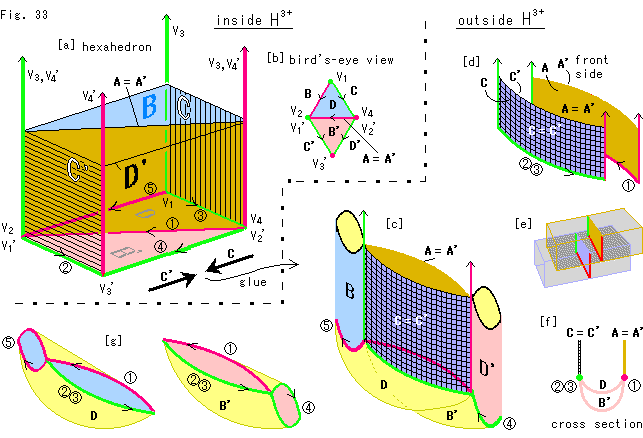
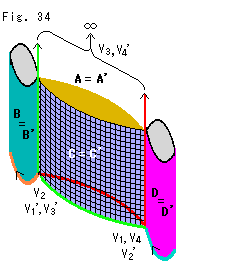
Fig. (30') shows the final picture with glued faces D = D' and B = B'. But we did not get it step by step. That is, we drew it without procedure. And we do not see that Topo. complement  is formed.
is formed.
Fig. (31) shows Pyramid made of [a] in Fig. (30) by gathering four edges that extend to a point of infinity . Faces C' and D' are transparent as well as Fig. (30). We mark a point with
. Faces C' and D' are transparent as well as Fig. (30). We mark a point with  where vertices
where vertices  and
and  ' met.
' met.
Separate edges at  in two groups, red edges
in two groups, red edges  ,
,  and green edges
and green edges  ,
,  . And pole between the two groups. Do it without question.
. And pole between the two groups. Do it without question.
Fig. (31') shows it. Faces B and B' stand like a book. Their outside surfaces are colored in yellow. If you close the book, you will get glued surface B = B'.
Fig. (31'') shows that faces B and B' are glued. Drawing glued faces A = A' and B = B' is omitted. To tell the truth, I myself can not understand this picture, but get tired. So please forget it.
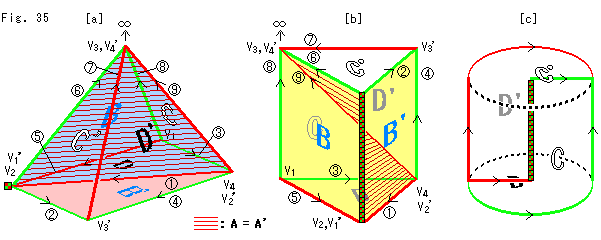
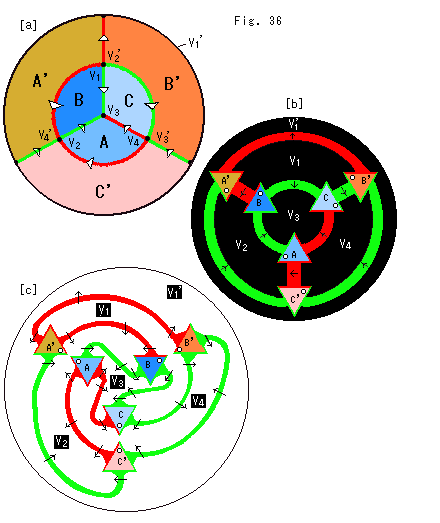
Fig. (32) is to see where we come to deadlock for physical gluing.
Again we refer to A Topological Picturebook by George K. Francis. A vertex is a point and has no size, and an edge has length and no width. Surprisingly his idea is to let vertices get bigger and widths of edges get wider.
Let us start with the unfolded hexahedron in Fig. (15').
[a]: Areas painted over with black are deformed vertices. Edges are very deformed as if length and width were exchanged. Small white circles are to indicate relations among vertices, edges and faces. Glued face D and D' is omitted.
[b]: Faces A, B and C are turned clockwise to get close to faces A', B' and C' respectively. Every face is twisted so that small white circle marks get face to face. Vertices now are not painted over with black but have black labels.
Now look at this picture carefully. It seems that we can glue face B to face B' like closing a book, C to C' as well. But we can not do the same for faces A and A'. Directions of edges do not meet. If we turn over face A or A', the white marks will not meet. We can not find a way to solve this problem concretely. Here we can not help but give up.
However, George connects vertices through an underground passage and snake-look edges along an overpass. And he glue faces A and A'. Well, his picture is so complicated that it is no more illustration for us.
* * * * * * *
Mathematical gluing
* * * * * * *
Fig. (33) below is what we are going to rely on formulae. We take vertices  and
and  as infinity
as infinity  rather than
rather than  and
and  . Because we begin with the hexahedron in Fig. (15).
. Because we begin with the hexahedron in Fig. (15).
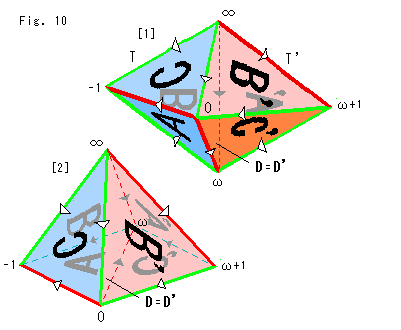
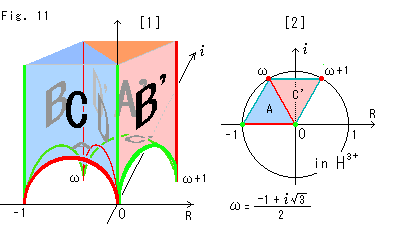
(a): The hexahedron is laid. It is made of regular ideal tetrahedra t and t'. But edges are drawn in straight for simple. Complex numbers are given to positions of vertices (actually no vertex) as shown.
(b): It is Pyramid that is deformed of (a).
Fig. (33') left shows Pyramid of (b) placed in the upper half space H3+. Faces A and C' are spherical. Faces B and B' are facing each other. It is up to this stage that can physically be done. The upper area is cut for easy to see.
Fig. (33'') is a bird's-eye view of Fig. (33'). R is real axis and i is imaginary axis.
Box left shows formulae (Mobius transformations) for gluing.
To get h(z) for gluing face A to face A', do as follows.
Give Z vertices of face A and give W vertices of face A'.
Solve Mobius transformation for a, b, c and d.
Substitute values of a, b, c and d in Mobius transformation.
For f(z) or g(z), do similarly.
These formulae certainly express the gluing in all faces. It frankly agrees such that vertex -1 changes to both vertex  and vertex 0 and also that both vertices -1 and
and vertex 0 and also that both vertices -1 and  change to common vertex
change to common vertex + 1. It treats what is physically impossible without any difficulty. There is no mathematical contradiction at all!
+ 1. It treats what is physically impossible without any difficulty. There is no mathematical contradiction at all!
However, it expresses only the gluing procedure. It is the same as verbal description. And it says nothing about the result of the gluing. If we refer to an advanced mathematical way, we have to go into more abstract area. That is, we see nothing.
Now we understand that we have no choice but to frankly accept the magical result through powerful imagination.
* * * * * * *
Abstract gluing
* * * * * * *
Gluing in geometrization is;
To do it abstractly without distorting the shape.
"without distorting the shape" is an agreement to keep regular ideal tetrahedra t and t' hyperbolic.
It seems to require us powerful imagination. But it is not so much. Put two regular ideal tetrahedra t and t' in front of you, and guess as if they are glued. You might be standstill if you try to imagine the process or result of the gluing at a time.
There are two ways of understanding the result of abstract gluing.
(dynamic view)
To trace a point following concrete result, e.g. one leaving t
reappears in t'.
(static view)
To accept abstract result as it is, e.g. two edges and four faces.
We pay attention to how it works or what nature it has rather than its appearance or mechanism.
* * * * * * *
Hyperbolic?
* * * * * * *
Is it obvious that what we get by the geometrization with regular ideal tetrahedra t and t' is hyperbolic?
Yes, it is. Because the way of the abstract gluing of regular ideal tetrahedra t and t' is done without distorting them.
That is,
What we make from hyperbolic object without distortion is hyperbolic.
Besides,
since we can choose only regular ideal tetrahedra t and t' for tetrahedra T and T',
we say that;
Geometry that we can get by the geometrization is only hyperbolic.
Now it is cleared up that Geom. complement has hyperbolic geometry.
Here after let us use symbol  for Geom. complement.
for Geom. complement.
Be that as it may, we wish to directly see if Geom. complement  itself is hyperbolic. However, only the above idea is available.
itself is hyperbolic. However, only the above idea is available.
* * * * * * *
Appearance of Geom. complement 
* * * * * * *
If we are required by force to draw Geom. complement  , we can not help but show something like an eggplant in Fig. (19). However, Geom. complement
, we can not help but show something like an eggplant in Fig. (19). However, Geom. complement  has certain shape though in abstract. Therefore, red and green edges are actually hyperbolic straight lines. Remember a number line has no end point but both ends extend to a point of infinity, and we assume that it is a straight line and yet a loop that passes the point at infinity. It reminds us Lobachevsky's idea (Ch.6), doesn't it? Situation on edges of regular ideal tetrahedra t and t' is the same as this number line because all edges extend to infinity. Invisible faces are also hyperbolic.
has certain shape though in abstract. Therefore, red and green edges are actually hyperbolic straight lines. Remember a number line has no end point but both ends extend to a point of infinity, and we assume that it is a straight line and yet a loop that passes the point at infinity. It reminds us Lobachevsky's idea (Ch.6), doesn't it? Situation on edges of regular ideal tetrahedra t and t' is the same as this number line because all edges extend to infinity. Invisible faces are also hyperbolic.
Picture of Geom. complement  :
:
1 lacked vertex at point of infinity ,
,
2 edges that are hyperbolic straight and infinitely extend,
4 hyperbolic faces,
2 regular ideal tetrahedra t and t' come out if taken apart.
The size of Geom. complement  is, of course, infinity. But its volume is finite. They say that the volume of figure-8 knot is 2.0298832... that is of two regular ideal tetrahedra. A knot is mathematically a curved line, and ordinarily it has no volume but length. However, the volume could be applied to Geom. complement
is, of course, infinity. But its volume is finite. They say that the volume of figure-8 knot is 2.0298832... that is of two regular ideal tetrahedra. A knot is mathematically a curved line, and ordinarily it has no volume but length. However, the volume could be applied to Geom. complement  .
.
What will come out if we slice Geom. complement  ? We are sure that something we can see comes out. If we cut Geom. complement
? We are sure that something we can see comes out. If we cut Geom. complement  in opposite way of gluing, we will get regular ideal hexahedra t and t'. But it is not what we want. Since the object is three dimensional, we think we can cut it with an ordinary knife. But, sorry to say, author does not know how to do it at this moment. How about unfold or depress? Please imagine. Or, soap film on the eggplant in Fig. (19). Please try.
in opposite way of gluing, we will get regular ideal hexahedra t and t'. But it is not what we want. Since the object is three dimensional, we think we can cut it with an ordinary knife. But, sorry to say, author does not know how to do it at this moment. How about unfold or depress? Please imagine. Or, soap film on the eggplant in Fig. (19). Please try.
* * * * * * *
What happens by the geometrization?
* * * * * * *
It is impossible to directly see Geom. complement  . But we can guess it as an assembled one by examining its components. They are regular ideal tetrahedra t and t' that are regarded as glued ones.
. But we can guess it as an assembled one by examining its components. They are regular ideal tetrahedra t and t' that are regarded as glued ones.
With this idea, we are going to see how Geom. complement  works or what nature it has.
works or what nature it has.
For the time being, we talk as if regular ideal tetrahedra t and t' are glued. (We do not apply the fact that Geom. complement  that is assembled has only two edges though we wish to use.)
that is assembled has only two edges though we wish to use.)
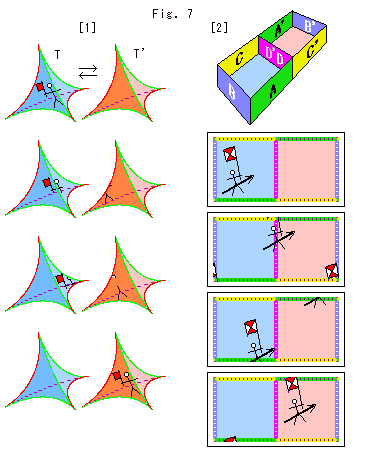
If a man walks from the inside of regular ideal tetrahedron t and is going to pass through a face, he reappears in regular ideal tetrahedron t'. And if he leaves t', he gets in t again.
Fig. (34) intends to show this situation.
 : we can freely go and back between regular ideal tetrahedra t and t'. It is like the story of hypersphere made of glued two balls.
: we can freely go and back between regular ideal tetrahedra t and t'. It is like the story of hypersphere made of glued two balls.
 : Imagine lines (yellow, blue, light red and dark green with dots) are four glued faces. Sky blue and pink areas are inside of regular ideal tetrahedra t and t'. Black circumferences are trace of lacked vertex V (point of infinity) where we can not get to. Then, we will come back where we left even if we go straight ahead (arrow curve in
: Imagine lines (yellow, blue, light red and dark green with dots) are four glued faces. Sky blue and pink areas are inside of regular ideal tetrahedra t and t'. Black circumferences are trace of lacked vertex V (point of infinity) where we can not get to. Then, we will come back where we left even if we go straight ahead (arrow curve in  ).
).
 : It shows the same thing as
: It shows the same thing as  but identical t and t' are arranged alternately. Every small circle is a trace of lacked vertex V where four faces (lattice lines) gather and we can not get to.
but identical t and t' are arranged alternately. Every small circle is a trace of lacked vertex V where four faces (lattice lines) gather and we can not get to.

Fig. (35) is what we imagine  of Fig. (34) where a man walks from one to the other.
of Fig. (34) where a man walks from one to the other.
Fig. (35') below is also an imagined four-frame comic strip. The picture under the comic shows an assignment of rooms t and t' (regular ideal tetrahedra). Each room has four magical walls made of glued faces (yellow, blue, light red and dark green with dots). Edges of walls are colored in red and green but these are omitted in the comic strip. Since rooms t and t' have four common walls, room t' (pink) is divided in two for drawing. (You may divide room t (sky blue) instead.) The small circle at the center is a trace of lacked vertex V (point of infinity).
A knight starts from room t and goes right-up-ward. He gets in room t'. He never touches the corner (infinity) though the picture looks so. And when he passes a magical wall of room t', he reappears in room t where he started.
(We do not care about an object larger than the comic frame that is Geom. complement  .)
.)
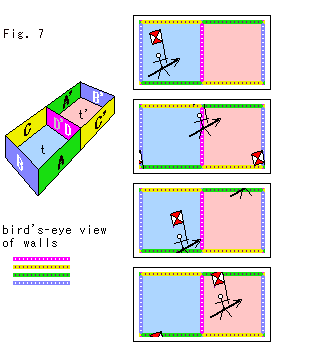
* * * * * * *
In whole hyperbolic space 
* * * * * * *
Geom. complement  is not whole hyperbolic space
is not whole hyperbolic space  . So we have a choice of location for regular ideal tetrahedra t and t' in Poincare ball
. So we have a choice of location for regular ideal tetrahedra t and t' in Poincare ball  .
.
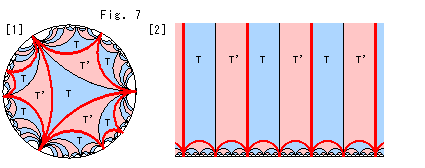
Tile regular ideal tetrahedra in Poincare ball  . Take two of them that are next to each other for regular ideal tetrahedra t and t'. We denote the pair by (t, t').
. Take two of them that are next to each other for regular ideal tetrahedra t and t'. We denote the pair by (t, t').
Regard equilateral ideal triangles in Poincare disk as regular ideal tetrahedra in Pincare ball  .
.
Fig. (36) shows this Poincare disk with some pairs of (t, t') that are surrounded by red lines. Three sides of the equilateral ideal triangle are actually four edges of the regular ideal tetrahedron. Areas surrounded by red lines are examples of (t, t'). Vertices of infinite number of regular ideal tetrahedra gather at every vertex. It is the same as that of regular ideal tetrahedra. But no picture is drawn as to dihedral angles.
Fig. (36') is the upper half plane H+ with pairs of (t, t') copied from Fig. (36). In 3-D also we can take t and t' alternately.
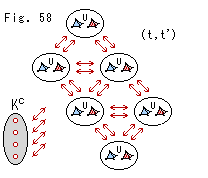
Fig. (37) is a mapping though arrow lines are omitted. It may look one to one mapping is broken but it is not true. Because one to one mapping is to be kept between two homeomorphic objects.
Fig. (38) shows an example of one to one mapping network. All of (t, t') are mutually homeomorphic. Of course, they are always homeomorphic to Orig. complement  .
.
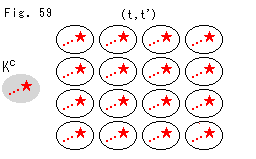
Suppose Poincare ball  is filled with infinite number of (t, t'). Infinite number of what we regard as vast and boundless! Every (t, t') fits hyperbolic space
is filled with infinite number of (t, t'). Infinite number of what we regard as vast and boundless! Every (t, t') fits hyperbolic space  perfectly without a gap. And if we put
perfectly without a gap. And if we put  in one of (t, t'), it appears in all of (t, t'). In Orig. complement
in one of (t, t'), it appears in all of (t, t'). In Orig. complement  , too.
, too.
Fig. (39) shows those in lattice and  . This lattice is different from
. This lattice is different from  in Fig. (34). Every (t, t') is not at the same position. If we move one of appeared
in Fig. (34). Every (t, t') is not at the same position. If we move one of appeared  , all of them moves simultaneously. (cf. red stars in hyperbolic regular octagon in Ch.33)
, all of them moves simultaneously. (cf. red stars in hyperbolic regular octagon in Ch.33)
Residents in a certain (t, t') can not go out of it though they appear in all other (t, t'). But it is OK because there is no outside for them who are faithful to the regulation of gluing. On the contrary, none of (t, t') exists for residents who do not know the regulation.
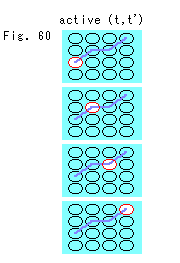
Look at Fig. (39'). It is not necessary to reappear or get back to the started area if we make an agreement that we measure the location of a point only in (t, t') where the point stays in.
[a]: A point moves on the agreement. Decide t or t' that has the point at the beginning, and then all (t, t') are automatically settled.
[b]: The same movement as [a] is done in a regular ideal hexahedron.

Fig. (40) shows some of (t, t') in Poincare ball  .
.
Now, if Poincare ball  is filled with (t, t'), we can say that everywhere is Geom. complement
is filled with (t, t'), we can say that everywhere is Geom. complement  !
!
* * * * * * *
Summary
* * * * * * *
Fig. (41) below shows our story summarized.
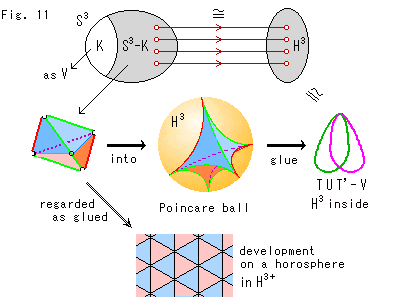
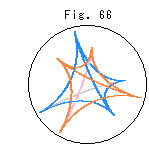 Aiming to the geometrization, we omit unnecessary things that are the strange solid and Topo. complement
Aiming to the geometrization, we omit unnecessary things that are the strange solid and Topo. complement  . Also (t, t') is omitted for simplifier.
. Also (t, t') is omitted for simplifier.
Follow black arrows from left top.
Make the hexahedron of Fig. (15) from Orig. complement  , and cut off its vertices.
, and cut off its vertices.
Replace it with a regular ideal hexahedron sitting in Poincare ball. Since we use the regular ideal hexahedron, we do not need to worry about doubling regular ideal tetrahedra (Fig. (42)). (If you make the regular ideal hexahedron directly from Orig. complement  , the disposal of vertices can not be done properly.)
, the disposal of vertices can not be done properly.)
And abstractly glue faces of the regular ideal hexahedron at other place rather than in Poincare ball  . Then we get Geom. complement
. Then we get Geom. complement  . (If you ask us where the gluing location is, we can not help but say, "in your mind".)
. (If you ask us where the gluing location is, we can not help but say, "in your mind".)
This Geom. complement  fits perfectly to hyperbolic space
fits perfectly to hyperbolic space  . So we embed it in Poincare ball
. So we embed it in Poincare ball  again though it is not necessary. Two edges and four faces gather at the tip of Geom. complement
again though it is not necessary. Two edges and four faces gather at the tip of Geom. complement  . And the tip is on the reverse side (inner, r < 1) of the surface of Poincare ball
. And the tip is on the reverse side (inner, r < 1) of the surface of Poincare ball  .
.
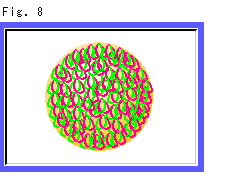
Fig. (43) is a symbolic full picture of Geom. complement  of figure-8 knot in consideration of (t, t'). (Though 3-D tiling would be a finished goods,)
of figure-8 knot in consideration of (t, t'). (Though 3-D tiling would be a finished goods,)
This is our finished goods. How do you like it?
Let us modify formula (1) from the viewpoint of the geometrization. It is written as
 - K = t U t'. ... (5)
- K = t U t'. ... (5)
Using our symbols,
 =
=  ( = (t, t')). ... (6)
( = (t, t')). ... (6)
Of course, these should be with appropriate explanations.
If you ask us "Why does hyperbolic geometry come out?", we answer, "Because we intentionally followed the above story." But the essential reason is that figure-8 knot has a character to produce hyperbolic geometry.
Implying this meaning, though (part of) hyperbolic space is Geom. complement, they say
Figure-8 knot complement is hyperbolic space.
And the definition of a hyperbolic knot is "a knot that has a complement that can be given a metric of constant curvature -1." Naturally Geom. complement  has curvature -1. So we can say
has curvature -1. So we can say
Figure-8 knot is a hyperbolic knot.
-*- -*- -*- -*- -*- -*- -*- -*- -*- -*-
[Addenda]
* * * * * * *
Other pictures of figure-8 knot

We have more pictures of figure-8 knot that are projected on a plane besides Fig. (1') to (2'') and Fig. (7).
Fig. (44) shows some of them. Symmetric part is colored in red for easy to see.
Figure-8 knot is called an alternating knot. It is a knot with a projection that has crossings that alternate between over and under as one travels around the knot in a fixed direction. All drawings are actually alternating knots though only  looks so.
looks so.  looks like a tetrahedron, doesn't it?
looks like a tetrahedron, doesn't it?  looks as if it carries a balloon inside. In web there are pictures of films,
looks as if it carries a balloon inside. In web there are pictures of films,  in CS284 Project Report and
in CS284 Project Report and  in Soap Films on Knots.
in Soap Films on Knots.
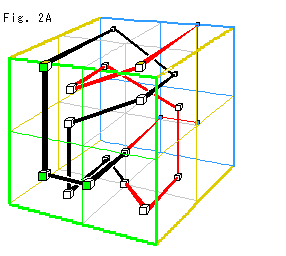
Fig. (44') is the figure-8 knot drawn in a jungle gym. Small cubes show digitized points on knot K. The coloring outer frame of the jungle gym is just for your observation.
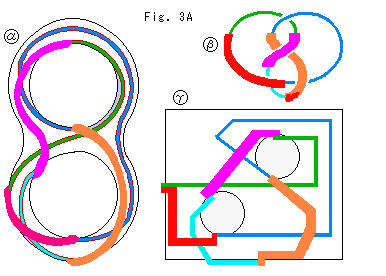 One more picture.
One more picture.
The figure-8 knot can be mounted on a double-float without crossing on the surface. (Both knot K and a double-float have hyperbolic geometry, but they have no common key.)
Look at Fig. (45).
 : The double-float is transparent and knot K is colored part by part for easy to see. Thick reddish lines are on the upper side (your side) and bluish lines are on the bottom side (beyond screen).
: The double-float is transparent and knot K is colored part by part for easy to see. Thick reddish lines are on the upper side (your side) and bluish lines are on the bottom side (beyond screen).
 : Colored parts of knot K correspond in color to those of
: Colored parts of knot K correspond in color to those of  .
.
 : It shows how crossings are avoided. Green line is the key route. Compare it with
: It shows how crossings are avoided. Green line is the key route. Compare it with  .
.
 : The double-float has a cusp when knot K passes through a point of infinity
: The double-float has a cusp when knot K passes through a point of infinity 
* * * * * * *
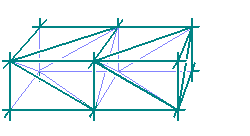 Euler number on 3-D
Euler number on 3-D
Let us apply 3-D Euler number to see if Topo. complement  is manifold. We use it here formally without question.
In three-dimension we use a tetrahedralization. (Most people commonly use a term triagulation (cf. Ch.29) for tetrahedralization.) We decompose a solid into tetrahedra so that they have no gap and no intersections. Fig. (46) is an example of tetrahedralization though it is in
is manifold. We use it here formally without question.
In three-dimension we use a tetrahedralization. (Most people commonly use a term triagulation (cf. Ch.29) for tetrahedralization.) We decompose a solid into tetrahedra so that they have no gap and no intersections. Fig. (46) is an example of tetrahedralization though it is in  . The formula of 3-D Euler number
. The formula of 3-D Euler number  is
is
 = v - e + f - s
= v - e + f - s
where
s is number of decomposed tetrahedra.
The right side is in dimensional order as well as 2-D Euler number. However, 3-D Euler number does not tell us characters of a solid as 2-D Euler number does. Because 3-D Euler number is not topological invariant. Yet, it is certain that the solid is a 3-manifold if 3-D Euler number is zero. (The converse may not be true.)
The strange solid T U T' has v = 1, e = 2, f = 4. And s = 2 because it consists of two tetrahedra.
Then
 = 1 - 2 + 4 - 2 = 1.
= 1 - 2 + 4 - 2 = 1.
It is not zero. the strange solid T U T' is not a manifold.
On Topo. complement  T U T' - V, v = 0.
T U T' - V, v = 0.
And
 = 0 - 2 + 4 - 2 = 0.
= 0 - 2 + 4 - 2 = 0.
That is, Topo. complement  is a manifold. (Topologists love manifolds very much, and want cut off vertices earlier as possible.)
is a manifold. (Topologists love manifolds very much, and want cut off vertices earlier as possible.)
* * * * * * *
Other hyperbolic knots
There are many hyperbolic knots besides figure-8 knot. You may visit Hyperbolic knot census.
Also friends of a knot called links have hyperbolic structure. Typical examples are Whitehead link and Borromean ring. But they use regular ideal octahedra for geomerization.
Fig. (47) is Whitehead link which 3-D picture is copied from Fancy Knots and Links.
Fig. (48) is Borromean ring which 3-D picture is copied from The KnotPlot Site
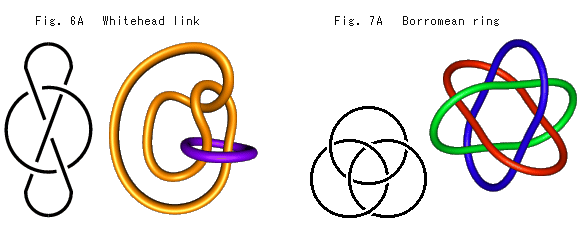
* * * * * * *
tripus
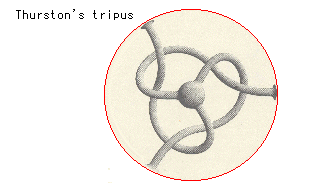
There is a monster of figure-8 knot called Thrston's tripus or knotted Y. Fig. (49) is the monster.
Fig. (49') is a revised picture of Fig. (15'). It has new marks only on faces. Edges are not distinguished by color. (If we could apply this trick to [b] in Fig. (32), we can glue face A to face A'.) Now glue two tetrahedra, then their vertices grow into three legs. It is rather complicate. Erase glued faces, pull out vertices, join edges and let them snake through underpasses, ... Let us enjoy the picture without question at this moment.
* * * * * * *
I asked Bill Thurston before writing this story. (He knew I am an amateur.)
Q: Topology does not care of distances. On the other hand, geometry needs
distances. Do you newly define a distance for the geometrization?
A: No. It is a kind of translation just like English to Japanese.
Well, I could feel something true.
Also I asked George K. Francis.
Q: Why does hyperbolic geometry come out?
A: Do not say, "Why". You should ask "How".
* * * * * * *
In short
Abstract gluing is a key point for us. How to understand it is a question. The answer is nothing but imagination. Nevertheless, what we get by the imagination really exists! (Mathematicians do not discuss existence, though.)
* * * * * * *
Be that as it may, don't you feel something doubtful?
Don't you think the story is too much tricky? You see, hyperbolic geometry is of the universal scale. It comes out from figure-8 knot in your hand. It sounds mysterious.
Some mathematicians say that we need powerful mathematics. However, it gets more accuracy only. Mathematical accuracy does not make us feel clear. What we need is explicit explanations. The author will try it more.
* * * * * * *
Now we have come to the most advanced mathematics in 1976. You might think 1976 is old. But it is not true. Surprisingly it is still fresh. They say that figure-8 knot relates to what is called Poincare conjecture.
Mathematical near future is full of romance. We are now in the Revolution Eve!
* * * * * * *
Separate pages:
Shape of Film
True Character of Vertices




 "the union ... in a particular way" means gluing with high technique and full imagination in our story. The gluing will be the key point.
"the union ... in a particular way" means gluing with high technique and full imagination in our story. The gluing will be the key point.



 Fig. (8) is a photo of a metal wire Knot K dipped in shampoo. But it is hard to see, isn't it? We are able to see a certain part of the film but not the whole. It is such that the wire with the film goes through another part of the film (the wire crosses in two-level and the film intersects itself). The film is transparent but it is not easy to see beyond the film surface. There is no way to see the whole shape of the film on knot K unless you draw it apart. All you have to do is to cut the film in some pieces along a line of film intersection. But, seeing Fig. (3''), there are so many color change points where the film intersects itself. I can not find proper cut-line. I had no choice but I could refer to A Topological Picturebook by George K. Francis. You will see the whole shape with Fig. (9) to (11) below.
Fig. (8) is a photo of a metal wire Knot K dipped in shampoo. But it is hard to see, isn't it? We are able to see a certain part of the film but not the whole. It is such that the wire with the film goes through another part of the film (the wire crosses in two-level and the film intersects itself). The film is transparent but it is not easy to see beyond the film surface. There is no way to see the whole shape of the film on knot K unless you draw it apart. All you have to do is to cut the film in some pieces along a line of film intersection. But, seeing Fig. (3''), there are so many color change points where the film intersects itself. I can not find proper cut-line. I had no choice but I could refer to A Topological Picturebook by George K. Francis. You will see the whole shape with Fig. (9) to (11) below.
 In Fig. (9) it looks that parts of film F around partitions are triply taken. But it is not true.
In Fig. (9) it looks that parts of film F around partitions are triply taken. But it is not true.
 Color and direction of edges must meet each other for joining four triangles. Only triangle D in Fig. (9) has to be turned over. This construction is to get a single sheet of film F again without twisting. Black spots on vertices are points shortened strings. Separated pieces of knot K get pushed to vertices.
Color and direction of edges must meet each other for joining four triangles. Only triangle D in Fig. (9) has to be turned over. This construction is to get a single sheet of film F again without twisting. Black spots on vertices are points shortened strings. Separated pieces of knot K get pushed to vertices.
 Fig. (15) above shows a hexahedron with faces D and D' glued. Cut it open at vertex
Fig. (15) above shows a hexahedron with faces D and D' glued. Cut it open at vertex  We glue tetrahedra T and T' by outside to outside. Do not glue only faces like [a] in Fig. (16') because every face has a part of Hf. complement
We glue tetrahedra T and T' by outside to outside. Do not glue only faces like [a] in Fig. (16') because every face has a part of Hf. complement  Fig. (17) is what we are forced to draw a picture of this strange solid.
Fig. (17) is what we are forced to draw a picture of this strange solid. Look at Fig. (18). Mr. E is observing Flatland. There is a something blue in Flatland. He can see the blue one entirely and recognize it as a circle immediately. In Flatland the blue one looks like a segment for Mr. S.
Look at Fig. (18). Mr. E is observing Flatland. There is a something blue in Flatland. He can see the blue one entirely and recognize it as a circle immediately. In Flatland the blue one looks like a segment for Mr. S. Now, cut off vertex V of the strange solid as shown in Fig. (19). The remainder including faces is Topo. complement
Now, cut off vertex V of the strange solid as shown in Fig. (19). The remainder including faces is Topo. complement  Fig. (20) shows some trial imaginary pictures of Topo. complement
Fig. (20) shows some trial imaginary pictures of Topo. complement 


 We have used different colors for surfaces even where they were stuck each other. But it is not right.
We have used different colors for surfaces even where they were stuck each other. But it is not right.
 Look at Fig. (25'). The hypersphere
Look at Fig. (25'). The hypersphere 
 Tetrahedra T and T' together have 6 red edges and 6 green edges to be glued in one red edge and one green edge respectively. That is to say, 6 dihedral angles gather at a place. (A dihedral angle is the angle formed by two intersecting faces.) Therefore, it is quite convenient for us to use regular ideal tetrahedra t and t' because their dihedral angles are exactly 60
Tetrahedra T and T' together have 6 red edges and 6 green edges to be glued in one red edge and one green edge respectively. That is to say, 6 dihedral angles gather at a place. (A dihedral angle is the angle formed by two intersecting faces.) Therefore, it is quite convenient for us to use regular ideal tetrahedra t and t' because their dihedral angles are exactly 60
















 Aiming to the geometrization, we omit unnecessary things that are the strange solid and Topo. complement
Aiming to the geometrization, we omit unnecessary things that are the strange solid and Topo. complement 


 One more picture.
One more picture. Euler number on 3-D
Euler number on 3-D
